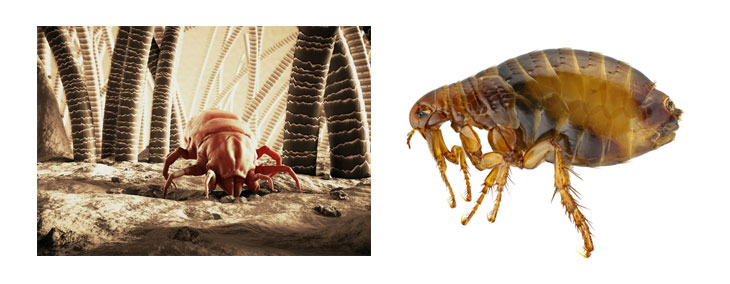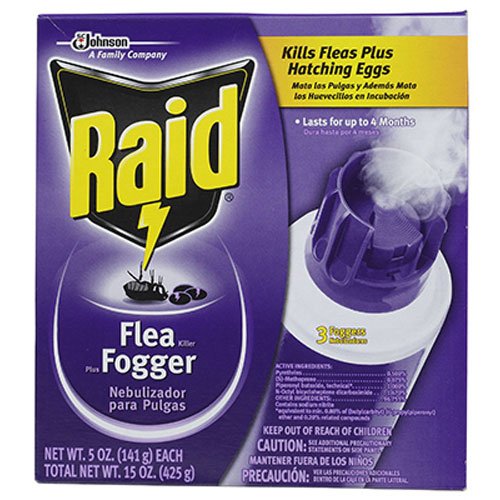Fleas vs Dust mites: What’s the Difference?
Fleas and dust mites are both small pests that can be unwelcome visitors in the home.
Understanding the differences between them and learning to identify which pest problem you have is the first step to eliminating the issue and living a pleasantly pest-free life.
Contents
Quick Comparison: Fleas vs Dust mites
| Fleas | Dust Mites |
|---|---|
| Average length 3mm | Average length 0.3mm |
| Flightless insects | Arthropods |
| Feed on blood | Feed on dead skin cells |
| Carry diseases | Do not carry diseases |
| Can cause contact dermatitis | Can cause allergic rhinitis |
| Can live in carpet and upholstery | Can live in carpet and upholstery |
| Can be prevented with good housekeeping | Can be prevented with good housekeeping |
| May require professional pest control | May require professional pest control |
Fleas

Fleas are tiny flightless insects that act as external parasites to mammals. These blood-sucking bugs measure up to 3mm in length and generally have brown bodies.
Because they are so small, it’s difficult to see them clearly with the naked eye. You might only see a brown-black speck.
One of a flea’s most identifying features is its ability to jump. Because these insects have no wings, they rely on their large hind legs for transportation.
Fleas can jump a tremendous distance, up to 50 times their height, and use this ability to jump between hosts.
Adult fleas drink blood and prefer to hide in the fur of animals like dogs and cats. They thrive in warm and moist climates and are most active during the summer months.
In many cases, you might not see a flea at all until the infestation becomes severe. The first sign of fleas may be itching in you or your family pet. Flea saliva contains a compound that causes itching and allergies.
Dust Mites

Dust mites are tiny arthropods, making them closer relatives to ticks and spiders than to fleas. Mites are nearly impossible to see with the naked eye.
An adult dust mite measures roughly 0.3mm in length, making it one tenth the size of a flea.
Dust mites feed on certain fungi and molds as well as flakes of skin. There are other species of mites that are parasitic, but dust mites do not bite humans or animals.
However, their waste is allergenic to many people. Dust mites are a common source of allergies, and they can be especially dangerous to people with asthma.
Fleas vs Dust Mites at a Glance
Both fleas and dust mites can cause allergies. However, the symptoms of these allergies are quite different.
Flea allergies are caused primarily by flea saliva. This may result in contact dermatitis, which creates itchiness and red bumps or rashes on the skin.
Humans and animals alike can have flea allergies. Fleas can also transmit tapeworms and some diseases.
Mites do not transmit disease, but they can cause symptoms that resemble a cold or flu in people with dust mite allergies.
Allergy symptoms for dust mites include sneezing, runny nose, itchy eyes and coughing. Itchy skin can also occur if you come in contact with dust mites.
Dust mite and flea allergies can both be diagnosed by a physician after testing. If you are found to have an allergy, taking steps to remove these pests from your home can help to alleviate symptoms.
Getting Rid of Fleas and Dust Mites
The first step to eradicating pests from your home is to keep the home clean. As their name suggests, dust mites are often found in dusty areas and especially in fabric.
Vacuuming carpet and upholstery can get rid of many unwanted pests. Dusting surfaces and sweeping and mopping your floors will help control pest populations as well.
Fleas often enter the home from outside after hitching a ride on a family pet. Be sure that your pet is up-to-date with flea and tick protection.
This will repel fleas and kill any that feed from the pet, preventing an infestation. If your home already has a flea problem, many commercial “flea bombs” are available that can help fumigate the house and kill any fleas living inside.
Dust mites are somewhat trickier to kill. There are powders available that can be sprinkled into carpet that may help to kill mites.
Otherwise, your best line of defense is air quality management to reduce the amount of allergens in your home.
Change your HVAC filters on schedule to trap dust and other allergens. Wash your bedding frequently in hot water to kill any mites or eggs living there.
Carpeting is one of the biggest indoor habitats for both dust mites and fleas. If possible, consider trading carpet for tile or linoleum.
Otherwise, consider a low-pile carpet rather than a more plush style. This will provide less hiding space and be easier to keep clean.
Use a vacuum with a HEPA filter to suck up any bugs and their eggs. Try to use rugs that can be washed in hot water rather than those that cannot withstand cleaning.
Dust mites and fleas are both unpleasant pests that can cause significant problems for your family if left unchecked.
Fortunately, there are ways to prevent infestation or stop problems from getting worse. Keeping a clean house, killing bugs and their eggs, managing your home’s air quality and limiting your pet’s exposure to pests can all help to protect your family.
If you suspect you have a pest problem and cannot handle it with basic means, it may be time to contact a professional.
A pest control expert can help to identify major issues and help you return your home to a happy, healthy and pest-free state.
Sources:
http://www.aafa.org/page/dust-mite-allergy.aspx
https://www.thespruce.com/the-life-cycle-of-the-flea-3384211
https://en.wikipedia.org/wiki/Flea


